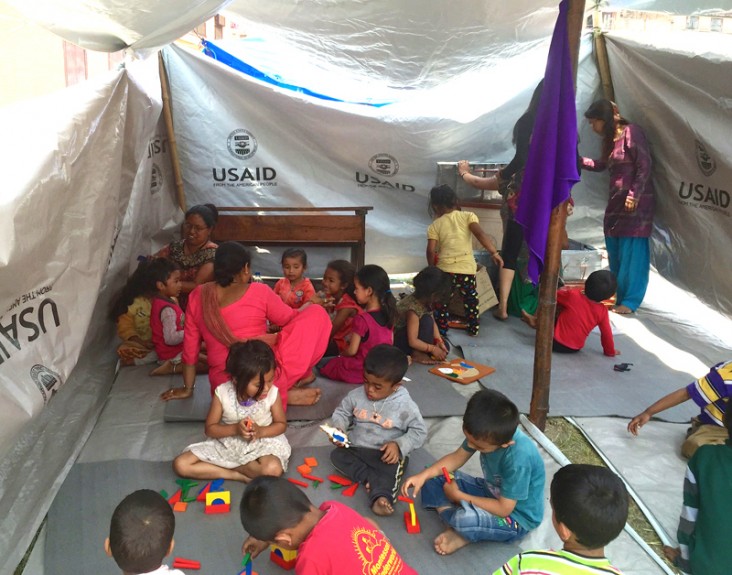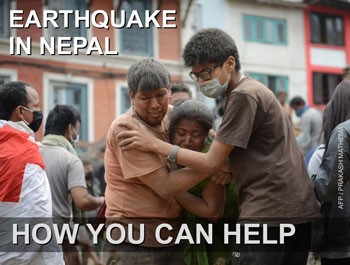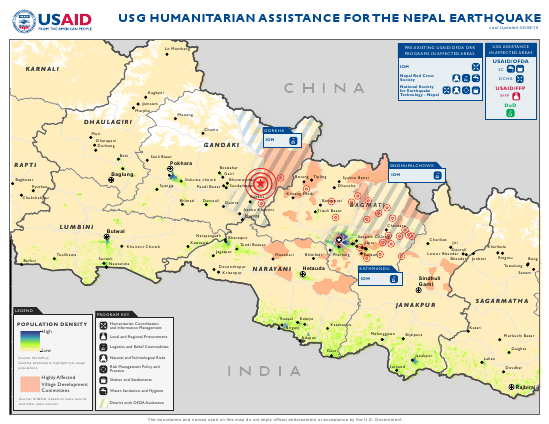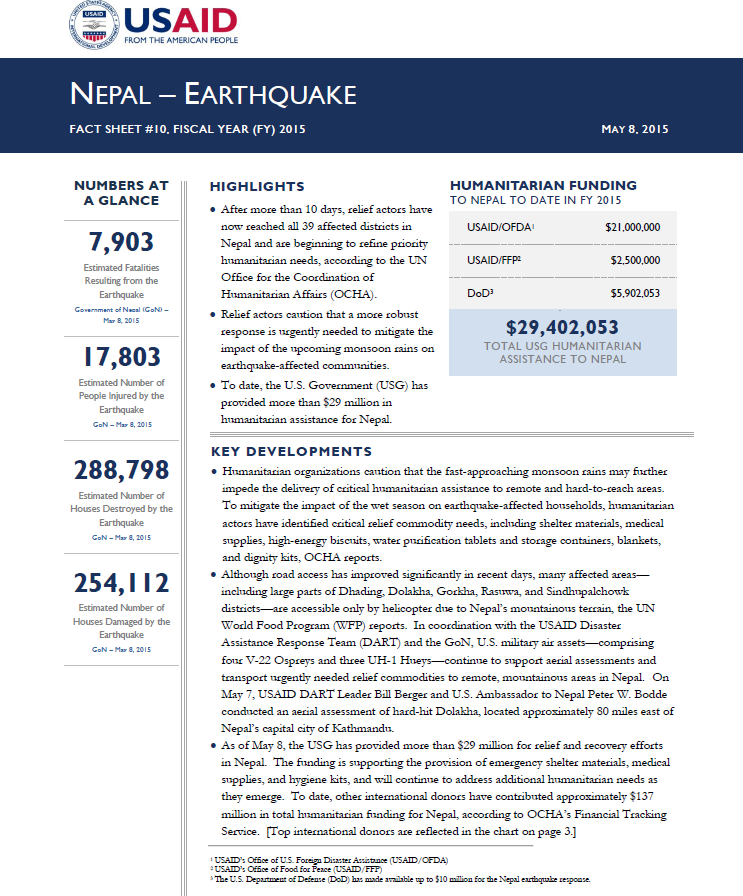May 8, 2015
Highlights
After more than 10 days, relief actors have now reached all 39 affected districts in Nepal and are beginning to refine priority humanitarian needs, according to the UN Office for the Coordination of Humanitarian Affairs (OCHA).
Relief actors caution that a more robust response is urgently needed to mitigate the impact of the upcoming monsoon rains on earthquake-affected communities.
To date, the U.S. Government (USG) has provided more than $29 million in humanitarian assistance for Nepal.
Key Developments
Nepal Earthquake Map - May 8, 2015 ![]() (pdf - 890k)
(pdf - 890k)
Numbers At A Glance
7,903
17,803
288,798
254,112
Humanitarian Funding:
To Nepal To Date In FY2015:
| USAID/OFDA | $21,000,000 |
| USAID/FFP | $2,500,000 |
| DoD | $5,902,053 |
| TOTAL | $29,402,053 |
Nepal Earthquake Fact Sheet #10 - 05-08-2015 ![]() (pdf - 269k)
(pdf - 269k)
Humanitarian organizations caution that the fast-approaching monsoon rains may further impede the delivery of critical humanitarian assistance to remote and hard-to-reach areas. To mitigate the impact of the wet season on earthquake-affected households, humanitarian actors have identified critical relief commodity needs, including shelter materials, medical supplies, high-energy biscuits, water purification tablets and storage containers, blankets, and dignity kits, OCHA reports.
Although road access has improved significantly in recent days, many affected areas—including large parts of Dhading, Dolakha, Gorkha, Rasuwa, and Sindhupalchowk districts—are accessible only by helicopter due to Nepal’s mountainous terrain, the UN World Food Program (WFP) reports. In coordination with the USAID Disaster Assistance Response Team (DART) and the GoN, U.S. military air assets—comprising four V-22 Ospreys and three UH-1 Hueys—continue to support aerial assessments and transport urgently needed relief commodities to remote, mountainous areas in Nepal. On May 7, USAID DART Leader Bill Berger and U.S. Ambassador to Nepal Peter W. Bodde conducted an aerial assessment of hard-hit Dolakha, located approximately 80 miles east of Nepal’s capital city of Kathmandu.
As of May 8, the USG has provided more than $29 million for relief and recovery efforts in Nepal. The funding is supporting the provision of emergency shelter materials, medical supplies, and hygiene kits, and will continue to address additional humanitarian needs as they emerge. To date, other international donors have contributed approximately $137 million in total humanitarian funding for Nepal, according to OCHA’s Financial Tracking Service.
SHELTER
According to May 8 GoN estimates, the April 25 earthquake had damaged or destroyed approximately 543,000 houses across Nepal, including destroying more than 40,000 in both Gorkha and Sindhupalchowk districts. The International Organization for Migration (IOM) and other organizations in the Shelter Cluster—the coordinating body for humanitarian shelter and settlements activities, comprising UN agencies, NGOs, and other stakeholders—are evaluating the availability of locally-sourced corrugated iron (CGI), as Nepalese communities commonly use CGI for roofing. Nepal’s two CGI factories are both fully operative, according to USAID partner National Society for Earthquake Technology-Nepal (NSET). However, the factories have insufficient capacity to meet the heightened demand resulting from extensive building damage. CGI is also much more expensive than plastic sheeting and more difficult to transport, according to USAID/OFDA’s shelter and settlements advisor.
USAID partners the Agency for Technical Cooperation and Development (ACTED) and Save the Children (SC) have distributed more than 700 rolls of USAID/OFDA-procured plastic sheeting—sufficient to benefit approximately 7,000 households or 35,000 people—to earthquake-affected communities in Gorkha, Sindhupalchowk, and Kathmandu Valley.
On May 8, the Shelter Cluster increased its original funding request in the UN flash appeal for the Nepal earthquake response from $50 million to $77 million due to the level of damage and destruction observed in earthquake-affected districts.
DISPLACEMENT
IOM continues to collect data on displacement in earthquake-affected districts, including in Kathmandu Valley, Gorkha, and Sindhupalchowk. In Gorkha, IOM’s Displacement Tracking Matrix (DTM) team reports that residents of severely impacted, remote villages have begun to relocate and are negotiating land access with other communities. However, the areas to which people are relocating are prone to landslides and flooding during the monsoon season.
In Gorkha’s Baguwa village development committee, DTM recorded more than 830 displaced persons residing in a camp setting. Another transitory group of approximately 1,000 people had traveled to the area to wait for humanitarian aid deliveries, which they reportedly intended to carry back to their remote and hard-to-reach mountain communities. The DTM team has also begun assessing sites in Sindhupalchowk's Chautara and Melamchi villages.

PROTECTION
The GoN Central Child Welfare Board recently found more than 20 children living outside a damaged residential children’s home—in which they had resided prior to the earthquake—in Lalitpur’s Khokana Village. Due to inadequate protection, the children have been relocated to temporary residential care facilities where protection actors are providing psychosocial support, and the Nepal Red Cross Society (NRCS) is conducting family tracing and reunification activities. As a precaution, the GoN has suspended inter-country adoption; relief agencies note that many children staying in children’s homes in Nepal are not orphans.
The Protection Cluster—led by the GoN Department of Women and Children—has highlighted several protection concerns in the aftermath of the earthquake, including providing adequate assistance to earthquake-affected women, children, people with disabilities, and senior citizens. In addition to considering the needs of these populations, humanitarian organizations also recognize the importance of being particularly vigilant regarding human trafficking issues. To enhance protection efforts, the cluster plans to identify a protection coordinator for 14 earthquake-affected districts in Nepal.
As of May 6, protection actors had established women-friendly spaces in Bhaktapur, Dhading, Kavrepalanchowk, and Lalitpur districts, and had distributed approximately 1,000 female dignity kits to women in Kavrepalanchowk, Lalitpur, and Sindhupalchowk. The Protection Cluster is also widely disseminating the code of conduct for humanitarian workers on prevention of sexual exploitation and abuse. According to UN Women, approximately 738,000 girls ages 14 and younger, 157,000 women ages 65 and older, 38,000 women with disabilities, and 318,000 female-headed households are living in 13 of the most-affected districts.
Members of the Education and Protection Clusters have also established 28 child-friendly spaces (CFSs) in Kathmandu Valley to promote art, play, and psychosocial support among displaced communities, the UN Children’s Fund (UNICEF) reports. SC and partners provided orientation for more than 100 CFS facilitators and volunteers on May 4, and as of May 6, more than 2,800 children were reportedly benefiting from these CFSs.
WASH
Preliminary WASH assessments in affected areas indicate that most of the earthquake related damage to latrines is to latrine superstructures rather than bases; WASH actors need to identify methods to effectively replace or repair superstructures in the early recovery phase.
On May 6, a USAID/OFDA water, sanitation, and hygiene (WASH) advisor arrived in Kathmandu to provide technical expertise to the DART and the greater humanitarian community. Since his arrival, the advisor has met with WASH Cluster actors to discuss priority assistance needs and coordinate response efforts across affected districts.
AGRICULTURE AND FOOD SECURITY
According to the GoN’s Ministry of Agriculture and Development (MoAD), the ministry has the capacity to handle agricultural needs arising during the first month after the earthquake. MoAD has identified areas for potential assistance from the international community, including reconstruction of livestock sheds; repair and reconstruction of damaged agricultural centers; small mechanized farming equipment; small-scale irrigation projects; and support to agribusinesses.
During a May 8 coordination meeting, agriculture and food security actors cautioned that seed interventions in Nepal must be targeted by topography as elevation affects the suitability of certain seeds for planting.
Markets in Nepal’s worst-affected districts are beginning to show signs of early recovery, according to a recent WFP assessment of 113 markets across 12 districts. As of May 8, nearly 40 percent of assessed markets were reported as operational, while 57 percent were reported as partially operational. Although the share of assessed markets reported as non-operational fell significantly during the past week, WFP notes that market functionality in mountainous areas remains disrupted. WFP also reports that food assistance is urgently needed in several of the worst-affected districts due to loss of food stocks, livelihoods, and limited access to markets.
To date, USAID/FFP has provided WFP with $2.5 million for the purchase of 1,390 metric tons (MT) of rice to address the food needs of approximately 120,000 earthquake-affected people for one month.
CONTEXT
On April 25, a magnitude 7.8 earthquake struck central Nepal at a shallow depth of approximately 15 kilometers (km), according to the USGS. The epicenter of the earthquake was located approximately 77 km northwest of Kathmandu, the country’s capital city, and 73 km east of Pokhara, another major city in central Nepal.
The USG immediately issued a disaster declaration for Nepal due to the effects of the earthquake. Within hours of the seismic event, USAID/OFDA had activated a RMT in Washington, D.C., and deployed a DART—including USAR specialists—to support emergency response efforts in Nepal.
For nearly two decades, USAID/OFDA has supported disaster risk reduction (DRR) efforts in Nepal, including throughout Kathmandu Valley. USAID/OFDA funding has enabled the International Organization for Migration (IOM) to identify, prepare, and preserve more than 80 open spaces in Kathmandu Valley to ensure the sites are available for humanitarian purposes—such as distribution centers or warehouses—in the event of large-scale disasters. USAID/OFDA has also supported NRCS to pre-position critical emergency relief supplies in order to address the immediate needs of affected communities following a disaster.
Through the Kathmandu-based National Society for Earthquake Technology (NSET), USAID/OFDA is strengthening Nepal’s earthquake response capacity by institutionalizing DRR at the local and national levels in collaboration with the GoN, non-governmental organizations, schools, and local communities. With USAID/OFDA support, NSET is also promoting public-private partnerships for earthquake risk management and enhancing the capacity of municipal governments to develop and administer building code permits and control systems to better protect against seismic activity.
PUBLIC DONATION INFORMATION
The most effective way people can assist relief efforts is by making cash contributions to humanitarian organizations that are conducting relief operations. A list of humanitarian organizations that are accepting cash donations for disaster responses around the world can be found at www.interaction.org.
USAID encourages cash donations because they allow aid professionals to procure the exact items needed (often in the affected region); reduce the burden on scarce resources (such as transportation routes, staff time, and warehouse space); can be transferred very quickly and without transportation costs; support the economy of the disaster-stricken region; and ensure culturally, dietary, and environmentally appropriate assistance.
More information can be found at:
- The Center for International Disaster Information: www.cidi.org or +1.202.821.1999.
-
Information on relief activities of the humanitarian community can be found at www.reliefweb.int.










Comment
Make a general inquiry or suggest an improvement.